 PDF(1425 KB)
PDF(1425 KB)


金针菇Fvpal1基因的RNAi降低PAL酶活及菌丝色素分泌
陆欢, 沈玲, 刘建雨, 尚晓冬, 王瑞娟, 谭琦, 唐桂容
菌物学报 ›› 2025, Vol. 44 ›› Issue (4) : 240258.
 PDF(1425 KB)
PDF(1425 KB)
 PDF(1425 KB)
PDF(1425 KB)
金针菇Fvpal1基因的RNAi降低PAL酶活及菌丝色素分泌
RNAi of the Flammulina filiformis Fvpal1 gene reduces PAL enzyme activities and mycelial pigment secretion
 ,
,  ,
,  ,
,  ({{custom_author.role_en}}), {{javascript:window.custom_author_en_index++;}}
({{custom_author.role_en}}), {{javascript:window.custom_author_en_index++;}}本研究构建了金针菇Flammulina filiformis苯丙氨酸解氨酶基因1 (F. filiformis PAL gene1,Fvpal1)的RNAi载体,以黄色的单核体菌株0990-⑤为受体,通过遗传转化获得5个基因沉默的单核转化子(RNAi-Fvpal1 1-5)。5个单核转化子再分别与白色的单核体菌株Dan3进行杂交,获得5个基因沉默的双核转化子(ZRNAi-Fvpal1 1-5)。考察并分析了单核转化子和双核转化子在PDA培养基上的菌丝生长速度、菌丝的PAL酶活、菌丝在培养基上的色素分泌及Fvpal1基因表达量情况,以验证Fvpal1基因具有调控金针菇颜色的功能。结果显示,10个转化子的Fvpal1基因表达较野生菌株相比都显著下调(P<0.05),其中转化子RNAi-Fvpal1 1-5分别下调83.41%、75.92%、79.69%、66.49%和43.22%,转化子ZRNAi-Fvpal1 1-5分别下调80.26%、45.24%、34.09%、84.05%和79.62%;除转化子ZRNAi-Fvpal1 4外的9个转化子的PAL酶活力都显著低于出发菌株(P<0.05)。10个转化子的菌丝在PDA培养基上的色素分泌都比出发菌株浅,双核转化子的菌丝在木屑培养基中的颜色也显著变浅,以及双核转化子的子实体颜色也比出发菌株浅。本研究构建了金针菇Fvpal1基因的RNAi体系,发现该基因对金针菇菌丝和子实体的颜色具有正调控作用,为进一步开展金针菇Fvpal1基因的功能基因研究提供了数据支撑。
RNA interference for the phenylalanine deaminase gene 1 of Flammulina filiformis (F. filiformis PAL gene1, Fvpal1) was constructed, and five gene-silenced mononuclear transformants (RNAi-Fvpal1 1-5) were obtained through genetic transformation by using the mononuclear strain 0990-⑤ (yellow) as the receptor. The five transformants were separately crossed with monokaryotic strain Dan3 (white) to obtain five gene-silenced binuclear transformants (ZRNAi-Fvpal1 1-5). The Fvpal1 gene expression and traits of the transformants such as mycelial growth rate in PDA medium, PAL enzyme activity, and mycelial pigment secretion were further investigated to verify that Fvpal1 gene has the function of regulating the color of F. filiformis. The results showed that Fvpal1 gene expression was significantly down-regulated in all 10 transformants as compared with that in wild strain (P<0.05). Mononuclear transformants RNAi-Fvpal1 1-5 were down-regulated respectively by 83.41%, 75.92%, 79.69%, 66.49%, and 43.22%, and binuclear transformants ZRNAi-Fvpal1 1-5 were down-regulated respectively by 80.26%, 45.24%, 34.09%, 84.05%, and 79.62%. All nine transformants except the binuclear transformant ZRNAi-Fvpal1 4 had significantly lower PAL-ase activity than the original strain 0990-⑤ (P<0.05). The mycelial pigment secretion of all the 10 transformants grown on PDA medium was lighter than that of the original strain, and the colour of the binucleate transformants became lighter even more significantly on woodchip medium. The fruiting body color of the binuclear transformants is also lighter than that of the strain 0990-⑤. In this study, the RNAi system of Fvpal1 gene of F. filiformis was constructed, and it was found that this gene had a positive regulatory effect on the color of mycelium and fruiting body of F. filiformis. The results provide preliminary evidence in support of further functional gene research of Fvpal1 of F. filiformis.
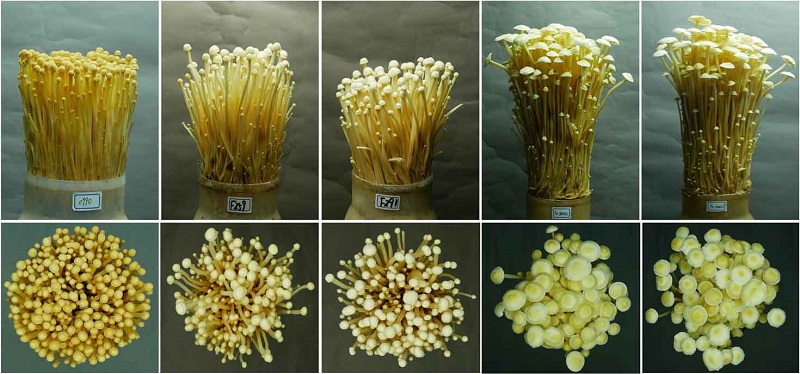
金针菇 / Fvpal1基因 / RNA干扰 / 颜色 {{custom_keyword}} /
Flammulina filiformis / Fvpal1 gene / RNA interference / colour {{custom_keyword}} /
表1 本研究所用的引物Table 1 Primers used in this study |
| 引物名称 Primer name | 引物序列 Primer sequence (5ʹ→3ʹ) |
|---|---|
| Fve-F | GG A CTAGTGGAAATGGACCTGCTACACTC |
| Fve-R | CG ACGCGTTGACCAATAGTAGGGTCATCG |
| Hyg-F | GATGTTGGCGACCTCGTATT |
| Hyg-R | TCGTTATGTTTATCGGCACTTT |
| Fl-F | GCAGGTCCGAGGTACTAAAG |
| Fl-R | ATCTCCGGAGGCTGAGATG |
| Qgpd-F | CTCGCTTTCCGTGTCCCTA |
| Qgpd-R | CATGGCAGCCTTGATCTCC |
| Qfv-F | CAAGGCACTAGTGTCTACGGC |
| Qfv-R | CAAGCCTCAGGCATGCTTG |
| 注:下划线中的引物序列为酶切位点 | |
| Note: Primer sequences underlined are enzyme cleavage sites. |

图1 金针菇RNAi目标序列PCR产物 1, 2:单核菌株0990-⑤扩增RNAi目标序列;3, 4:单核菌株Dan3扩增RNAi目标序列Fig. 1 RNAi target sequence PCR product of Flammulina filiformis. M: DL 2 000 DNA marker; 1, 2: The amplified RNAi target sequence of strain 0900-⑤; 3, 4: The amplified RNAi target sequence of strain Dan3. |

图3 RNAi载体RNAi-Fvpal1的构建及鉴定 A:RNAi-Fvpal1表达载体结构图. B:大肠杆菌菌液PCR凝胶电泳结果. C:RNAi-Fvpal1酶切凝胶电泳结果;M:DL 15 000 DNA marker;1:RNAi-Fvpal1质粒;2:SpeⅠ单酶切RNAi-Fvpal1条带;3:MluⅠ单酶切RNAi-Fvpal1条带;4:SpeⅠ和MluⅠ双酶切RNAi-Fvpal1条带Fig. 3 Construction and verification of the RNA interference RNAi-Fvpal1. A: RNAi-Fvpal1 plasmid structure map; B: PCR gel electrophoresis of Escherichia coli liquid; C: Gel electrophoresis of RNAi-Fvpal1 double enzyme digestion, M: DL 15 000 DNA marker, 1: RNAi-Fvpal1 plasmid, 2: SpeⅠmono-digested RNAi-Fvpal1 bands, 3 : MluⅠmono-digested RNAi-Fvpal1 bands, 4: SpeⅠand MluⅠdouble-digested RNAi-Fvpal1 bands. |
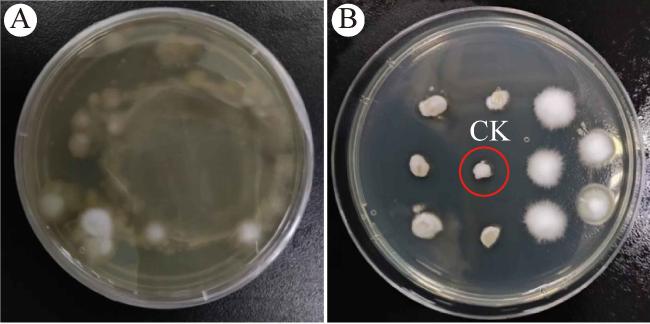
图6 初筛和复筛拟转化子菌丝生长情况Fig. 6 Mycelial growth of RNAi transformants in primary and secondary screening. |

图7 拟转化子特异引物PCR A:潮霉素基因PCR鉴定结果;M:DL 2000 DNA marker;1-10:拟转化子;11:原始菌株0990-⑤;12:ddH2O;13:RNAi-Fvpal1质粒;B:RNAi-Fvpal1的特异序列PCR鉴定结果;M:DL 2000 DNA marker;1-10:拟转化子;11:原始菌株0990-⑤;12:ddH2O;13:RNAi-Fvpal1质粒Fig. 7 PCR for specific primers of RNAi transformants. A: Identification results of RNAi-Fvpal1, M: DL 2 000 DNA marker, 1-10: RNAi-Fvpal1 transformants, 11: The original strain 0990-⑤, 12: ddH2O, 13: RNAi-Fvpal1 plasmid; B: PCR identification results of hydomycin gene, M: DL 2 000 DNA marker, 1-10: RNAi-Fvpal1 transformants, 11: The original strain 0990-⑤, 12: ddH2O, 13: RNAi-Fvpal1 plasmid. |

图8 菌株0990-⑤及RNAi-Fvpal1 1-5与菌株Dan3杂交菌株锁状联合图 A:0990-⑤和Dan3杂交菌株的锁状联合;B:RNAi-Fvpal1 1和Dan3杂交菌株的锁状联合;C:RNAi-Fvpal1 2和Dan3杂交菌株的锁状联合;D:RNAi-Fvpal1 3和Dan3杂交菌株的锁状联合;E:RNAi-Fvpal1 4和Dan3杂交菌株的锁状联合;F:RNAi-Fvpal1 5和Dan3杂交菌株的锁状联合Fig. 8 Clamp connection of mycelia (indicated with circles) of 0900-⑤ and RNAi-Fvpal1 1-5 hybridized with Dan3. A: 0900-⑤ hybridized with Dan3; B: RNAi-Fvpal1 1 hybridized with Dan3; C: RNAi-Fvpal1 2 hybridized with Dan3; D: RNAi-Fvpal1 3 hybridized with Dan3; E: RNAi-Fvpal1 4 hybridized with Dan3; F: RNAi-Fvpal1 5 hybridized with Dan3. |

图9 杂交菌株特异引物PCR A:杂交菌株RNAi-Fvpal1特异序列的PCR鉴定结果,M:DL 2 000 DNA marker;1-5:ZRNAi-Fvpal1拟转化子;6:0990-⑤×Dan3杂交菌株;7:RNAi-Fvpal1质粒;8:ddH2O;B:杂交菌株潮霉素基因的PCR鉴定结果,M:DL 2 000 DNA marker;1-5:ZRNAi-Fvpal1拟转化子;6:0990-⑤×Dan3原始菌株;7:RNAi-Fvpal1质粒;8:ddH2OFig. 9 Hybrid strain specific primer PCR. A: PCR identification results of the specific sequences of the hybrid strain RNAi-Fvpal1, M: DL 2000 DNA marker, 1-5: ZRNAi-Fvpal1 transformants, 6: The original strain 0990-⑤×Dan3, 7: RNAi-Fvpal1 plasmid, 8: ddH2O. B: PCR identification results of hydomycin gene, M: DL 2000 DNA marker, 1-5: ZRNAi-Fvpal1 transformants, 6: The original strain 0990-⑤×Dan3, 7: RNAi-Fvpal1 plasmid, 8: ddH2O. |
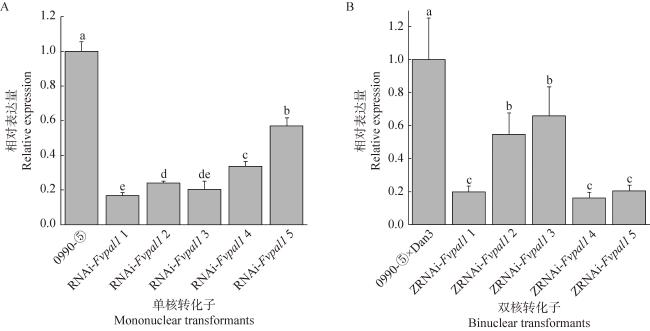
图10 Fvpal1在单核转化子和双核转化子中的表达水平 A:Fvpal1在对照菌株0990-⑤和单核转化子RNAi-Fvpal1 1-5的表达量;B:Fvpal1在0990-⑤×Dan3 and binuclear transformants ZRNAi-Fvpal1 1-5的表达量. 标有不同字母表示菌株间存在显著差异(P<0.05),标有相同字母表示菌株间不存在显著差异(P>0.05),下同Fig. 10 Expression level of Fvpal1 gene. A: The expression level of Fvpal1 gene in 0990-⑤ and mononuclear transformants RNAi-Fvpal1 1-5; B: The expression level of Fvpal1 gene in 0990-⑤×Dan3 and binuclear transformants ZRNAi-Fvpal1 1-5. Labeling with different letters indicates significant differences between strains (P<0.05), while labeling with the same letter indicates no significant differences between strains (P>0.05). The same below. |

图11 菌落形态观察结果(培养13 d) A:对照菌株和单核转化子在PDA培养基上的生长情况(正面);B:对照菌株和单核转化子在PDA培养基上的生长情况(背面),从左到右依次为:0990-⑤、RNAi-Fvpal1 1、RNAi-Fvpal1 2、RNAi-Fvpal1 3、RNAi-Fvpal1 4、RNAi-Fvpal1 5;C:对照菌株和双核转化子在PDA培养基上的生长情况(正面);D:对照菌株和双核转化子在PDA培养基上的生长情况(背面);E:对照菌株和双核转化子菌株在PDA培养基(含7 mg/L Hyg)上的生长情况(正面),从左到右依次为:0990-⑤×Dan3、ZRNAi-Fvpal1 1、ZRNAi-Fvpal1 2、ZRNAi-Fvpal1 3、ZRNAi-Fvpal1 4、ZRNAi-Fvpal1 5Fig. 11 Observation of colony morphology (cultured 13 d). A: The growth of control strain and mononuclear transformants in the PDA medium (obverse); B: The growth of control strain and mononuclear transformants in the PDA medium (reverse), from left to right: 0990-⑤, RNAi-Fvpal1 1, RNAi-Fvpal1 2, RNAi-Fvpal1 3, RNAi-Fvpal1 4 and RNAi-Fvpal1 5; C: The growth of control strain and binuclear transformants in the PDA medium (obverse); D: The growth of control strain and binuclear transformants in the PDA medium (reverse); E: The growth of control strain and binuclear transformants in a PDA medium (including 7 mg/L Hyg) (obverse), from left to right: 0990-⑤×Dan3, ZRNAi-Fvpal1 1, ZRNAi-Fvpal1 2, ZRNAi-Fvpal1 3, ZRNAi-Fvpal1 4 and ZRNAi-Fvpal1 5. |
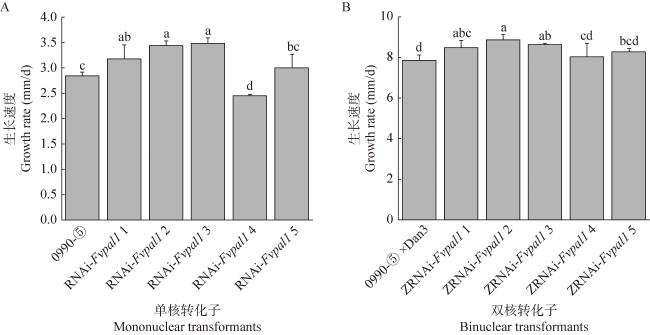
图12 菌丝在PDA培养基中的生长速度 A:对照菌株0990-⑤和单核转化子RNAi-Fvpal1 1-5的菌丝生长速度;B:对照菌株0990-⑤×Dan3和双核转化子ZRNAi-Fvpal1 1-5的菌丝生长速度Fig. 12 Mycelial growth rate in PDA medium. A: Mycelial growth rate of 0990-⑤ and mononuclear transformants RNAi-Fvpal1 1-5; B: Mycelial growth rate of 0990-⑤×Dan3 and binuclear transformants ZRNAi-Fvpal1 1-5. |
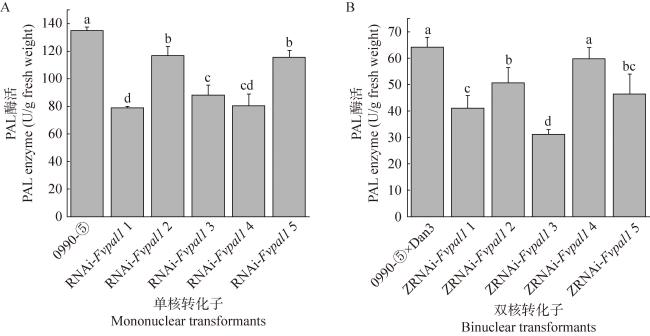
图13 菌丝的PAL酶活 A:对照菌株0990-⑤和单核转化子RNAi-Fvpal1 1-5菌丝的PAL酶活;B:对照菌株0990-⑤×Dan3和双核转化子ZRNAi-Fvpal1 1-5菌丝的PAL酶活Fig. 13 PAL enzyme activity of mycelium. A: PAL enzyme activity of 0990-⑤ and mononuclear transformants RNAi-Fvpal1 1-5; B: PAL enzyme activity of 0990-⑤×Dan3 and binuclear transformants ZRNAi-Fvpal1 1-5. |
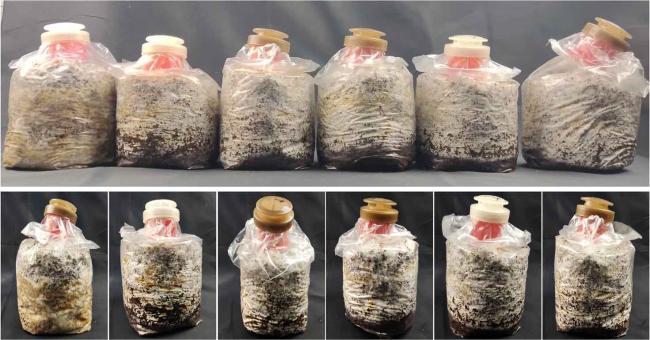
图14 双核转化子在木屑培养基中的生长情况 从左到右依次为0990-⑤×Dan3、ZRNAi-Fvpal1 1、ZRNAi-Fvpal1 2、ZRNAi-Fvpal1 3、ZRNAi-Fvpal1 4和ZRNAi-Fvpal1 5Fig. 14 Growth of binuclear transformants in sawdust medium. From left to right: 0990-⑤×Dan3, ZRNAi-Fvpal1 1, ZRNAi-Fvpal1 2, ZRNAi-Fvpal1 3, ZRNAi-Fvpal1 4 and ZRNAi-Fvpal1 5. |
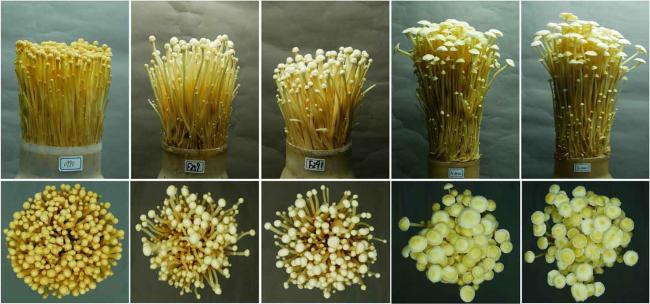
图15 对照菌株和双核转化子在工厂化栽培条件下子实体生长情况 从左到右依次为0990、0990-⑤×Dan3、0990-②×Dan3、ZRNAi-Fvpal1 1和ZRNAi-Fvpal1 2Fig. 15 The proliferation of fruiting bodies of the reference strain and the binucleate transformant under industrial cultivation conditions. From left to right: 0990, 0990-⑤×Dan3, 0990-②×Dan3, ZRNAi-Fvpal1 1 and ZRNAi-Fvpal1 2. |
| [1] |
{{custom_citation.content}}
{{custom_citation.annotation}}
|
| [2] |
{{custom_citation.content}}
{{custom_citation.annotation}}
|
| [3] |
Macrofungi, as an important component in forest ecosystems, consist of most members of Basidiomycota and some members of Ascomycota, having important economical value and ecological functions. Extensive field investigations have been carried out in almost whole types of the Chinese forests during the past 30 years, and 112 000 specimens were collected. Based on morphological examination and phylogenetic analyses in combination with ecology and biogeography, 4 250 species belonging to 21 orders in Baidiomycota and Ascomycota were identified, including two new families, four new subfamilies, 69 new genera and 885 new species. Yunnan Province is the richest in macrofungal diversity among provinces or regions in China, and 314 new species were described from this province, accounting for 35% of all the new species described from China by the authors. Our studies have made contributions to deepening the understanding of global diversity of macrofungi. The names of some important Chinese medicinal fungi were revised, the diversity characteristics of Chinese poisonous mushrooms were revealed, and the pathogenetic wood-decaying species were ascertained. These data improved our knowledge on utilization of natural resources and protection of forest health. Based on molecular evidences, the origin of some forest representative fungal genera or species complex were deduced, and their dispersal and speciation were discussed, for the purposes of providing some data for evolutionary study at level of family, order or class of macrofungi henceforth. {{custom_citation.content}}
{{custom_citation.annotation}}
|
| [4] |
{{custom_citation.content}}
{{custom_citation.annotation}}
|
| [5] |
{{custom_citation.content}}
{{custom_citation.annotation}}
|
| [6] |
{{custom_citation.content}}
{{custom_citation.annotation}}
|
| [7] |
{{custom_citation.content}}
{{custom_citation.annotation}}
|
| [8] |
{{custom_citation.content}}
{{custom_citation.annotation}}
|
| [9] |
{{custom_citation.content}}
{{custom_citation.annotation}}
|
| [10] |
{{custom_citation.content}}
{{custom_citation.annotation}}
|
| [11] |
{{custom_citation.content}}
{{custom_citation.annotation}}
|
| [12] |
{{custom_citation.content}}
{{custom_citation.annotation}}
|
| [13] |
{{custom_citation.content}}
{{custom_citation.annotation}}
|
| [14] |
{{custom_citation.content}}
{{custom_citation.annotation}}
|
| [15] |
{{custom_citation.content}}
{{custom_citation.annotation}}
|
| [16] |
{{custom_citation.content}}
{{custom_citation.annotation}}
|
| [17] |
{{custom_citation.content}}
{{custom_citation.annotation}}
|
| [18] |
{{custom_citation.content}}
{{custom_citation.annotation}}
|
| [19] |
{{custom_citation.content}}
{{custom_citation.annotation}}
|
| [20] |
{{custom_citation.content}}
{{custom_citation.annotation}}
|
| [21] |
{{custom_citation.content}}
{{custom_citation.annotation}}
|
| [22] |
{{custom_citation.content}}
{{custom_citation.annotation}}
|
| [23] |
{{custom_citation.content}}
{{custom_citation.annotation}}
|
| [24] |
{{custom_citation.content}}
{{custom_citation.annotation}}
|
| [25] |
{{custom_citation.content}}
{{custom_citation.annotation}}
|
| [26] |
{{custom_citation.content}}
{{custom_citation.annotation}}
|
| [27] |
{{custom_citation.content}}
{{custom_citation.annotation}}
|
| [28] |
{{custom_citation.content}}
{{custom_citation.annotation}}
|
| [29] |
{{custom_citation.content}}
{{custom_citation.annotation}}
|
| [30] |
{{custom_citation.content}}
{{custom_citation.annotation}}
|
| [31] |
戴玉成, 杨祝良, 2018. 中国五种重要食用菌学名新注. 菌物学报, 37(12): 1527-1577
{{custom_citation.content}}
{{custom_citation.annotation}}
|
| [32] |
戴玉成, 杨祝良, 崔宝凯, 吴刚, 袁海生, 周丽伟, 何双辉, 葛再伟, 吴芳, 魏玉莲, 员瑗, 司静, 2021. 中国森林大型真菌重要类群多样性和系统学研究. 菌物学报, 40(4): 770-805
大型真菌主要为担子菌门的真菌和少数为子囊菌门的真菌,该类真菌具有重要的经济价值和生态功能,主要生长在森林生态系统中。30年来作者对我国几乎所有类型森林生态中的大型真菌进行了系统调查和采集,共采集标本11.2万号。基于对这些材料的形态学及分子系统学研究,并结合生态学和生物地理学特征,共鉴定出中国森林大型真菌4 250种,隶属于担子菌门和子囊菌门的21个目,发现和发表2个新科、4个新亚科、69个新属和885个新种。云南省是我国森林大型真菌最丰富的省份,描述于该省的新种有314种,占作者发表的全部中国新种的35%。这些研究为深入认识全球大型真菌物种多样性提供了中国的贡献,更新了我国重要食药用菌名称,揭示了我国毒蘑菇多样性基本特征,系统论述了我国森林病原菌的物种多样性,为资源利用、森林健康和保护提供了科学依据;论述了森林大型真菌代表性类群在种和属级水平的起源和演化,为今后开展重要类群科级、目级甚至纲级的系统进化关系提供了重要数据。
{{custom_citation.content}}
{{custom_citation.annotation}}
|
| [33] |
胡梦蝶, 李佳伟, 王梅, 刘彬, 马钰聪, 赵雨露, 杨鑫雷, 崔顺立, 侯名语, 蒋晓霞, 穆国俊, 2022. 花生花斑种皮花青素生物合成相关miRNA及其靶基因鉴定与分析. 植物遗传资源学报, 23(1): 226-239
花生在世界粮油食品中占有重要地位,其种皮颜色有白色、红色、紫色、粉红色及花斑等多种颜色,花斑种皮花生是其独特的成员之一,具有便于区分的优良性状。本研究以花斑种皮花生VG-02为研究材料,结果表明与花斑种皮颜色合成相关差异表达的miRNA富集的代谢途径有苯丙烷生物合成、类黄酮生物合成、异黄酮的生物合成,昼夜节律-植物。miRNA测序结果中共筛选出86个差异表达miRNA,其中20个差异表达的miRNA与花生花斑种皮颜色合成相关。与花生花斑种皮花青素合成相关的20个差异表达miRNA包括miR_8、miR_50、miR_51和miR_239-x,这4个是共同靶向花青素、类花青素和IFS靶基因的miRNA;调控CHS靶基因的miR_398-x,调控4CL靶基因的miR_482,调控F3’H靶基因的miR_266和miR_182以及调控花青素3-O-葡萄糖苷靶基因的miR_5,这是5个靶向花青素生物合成中结构基因的miRNA;miR858-y靶向调控MYB2和MYB3,这是1个靶向花青素生物合成调节基因的miRNA;miR_10、miR_15、miR_61、miR_72、miR_102、miR_116、miR_123、miR_193、miR_256和miR_862-z这10个是靶向CYP450靶基因的miRNA。miRNA测序与转录组联合分析KEGG代谢通路表明类黄酮生物合成是花生种皮花斑形成最直接的代谢途径。本研究对于全面揭示花斑花生种皮花青素合成的分子机制有重要意义。
{{custom_citation.content}}
{{custom_citation.annotation}}
|
| [34] |
李海芬, 邱金梅, 陈小平, 洪彦彬, 梁炫强, 2017. 花生花青素合成相关基因的表达与种皮颜色关系. 中国油料作物学报, 39(5): 600-605
花生品种种皮颜色与花青素的积累有关,为了探讨花青素合成相关基因表达与种皮颜色的关系,本文采用HPLC和实时荧光定量PCR技术,分析4种不同种皮颜色的花生品种种皮花青素的种类和含量,以及花青素合成相关基因在4个品种5个荚果发育关键时期的差异表达。结果表明:花生种皮的花青素主要由飞燕草色素、矢车菊色素和天竺葵色素等三种色素组成;花生种皮的外观颜色和深浅主要由飞燕草色素和矢车菊色素含量决定,飞燕草色素和矢车菊色素含量越高,种皮颜色越深。花青素合成相关基因主要在种子充实期(开花后约40-50d)上调表达。花生种皮颜色的深浅与查耳酮合成酶基因(CHS)、查尔酮异构酶基因(CHI)、二氢黄酮醇4-还原酶基因(DFR)、类黄酮-3'羟化酶基因(F3'H )和花色苷合成酶基因(ANS)等基因在种子充实期(开花后约40-50d)高表达显著相关。上述5个基因表达量愈高,种皮颜色愈深。
{{custom_citation.content}}
{{custom_citation.annotation}}
|
| [35] |
刘丽娜, 2016. 金针菇颜色突变型的遗传属性研究. 湖南师范大学硕士论文, 长沙. 1-46
{{custom_citation.content}}
{{custom_citation.annotation}}
|
| [36] |
刘询, 刘天海, 王波, 贾定洪, 彭卫红, 何晓兰, 2023. 金针菇分子生物学和功能基因研究进展. 菌物学报, 42(1): 130-142
金针菇是重要的食药用菌,具有很高的经济价值。随着金针菇全基因组序列的公布、多组学分析、转基因技术、基因编辑技术的发展,越来越多的研究者开始关注金针菇重要性状(如生长速度、菌柄长度、生物活性物质含量等)相关的分子调控机制以及关键基因的发掘。本文综述了分子生物学技术在金针菇研究中的应用并分析了不同技术的利弊;同时,系统介绍了金针菇菌丝和子实体生长发育、温度应答、生物活性物质代谢、蓝光响应等重要生物学过程中调控基因的最新研究进展,并对未来金针菇分子生物学研究的方向进行了展望,旨在为我国金针菇产业的发展提供有价值的参考。
{{custom_citation.content}}
{{custom_citation.annotation}}
|
| [37] |
陆欢, 王瑞娟, 刘建雨, 宋春艳, 尚晓冬, 2021. 不同品种金针菇的营养成分分析与评价. 食品与机械, 37(6): 69-75, 96
{{custom_citation.content}}
{{custom_citation.annotation}}
|
| [38] |
王桂林, 杨宇, 李国辉, 杨洁, 赵二劳, 2021. 金针菇多糖生物活性研究进展. 中国食用菌, 40(12): 10-13, 18
{{custom_citation.content}}
{{custom_citation.annotation}}
|
| [39] |
王慧, 郭东方, 王鑫, 2021. 金针菇的营养保健功能及开发利用现状. 中国食用菌, 40(11): 11-14, 24
{{custom_citation.content}}
{{custom_citation.annotation}}
|
| [40] |
王艳, 2020. 灰树花杂交选育及其苯丙氨酸解氨酶基因的功能研究. 山东师范大学硕士论文,济南. 1-83
{{custom_citation.content}}
{{custom_citation.annotation}}
|
| [41] |
谢宝贵, 江玉姬, 吴文礼, 2004. 金针菇子实体颜色的遗传规律研究. 菌物学报, 23(1): 79-84
{{custom_citation.content}}
{{custom_citation.annotation}}
|
| [42] |
蚁瑞荣, 曹晖, 潘迎捷, 2007a. 金针菇单核出菇与子实体颜色. 食用菌学报, 14(2): 33-36, 91
{{custom_citation.content}}
{{custom_citation.annotation}}
|
| [43] |
蚁瑞荣, 曹晖, 潘迎捷, 2007b. 金针菇杂合菌株子实体颜色遗传分析. 食用菌学报, 14(4): 19-21, 91
{{custom_citation.content}}
{{custom_citation.annotation}}
|
| {{custom_ref.label}} |
{{custom_citation.content}}
{{custom_citation.annotation}}
|
 PDF(1425 KB)
PDF(1425 KB)
 表1 本研究所用的引物
表1 本研究所用的引物 图1 金针菇RNAi目标序列PCR产物 1, 2:单核菌株0990-⑤扩增RNAi目标序列;3, 4:单核菌株Dan3扩增RNAi目标序列
图1 金针菇RNAi目标序列PCR产物 1, 2:单核菌株0990-⑤扩增RNAi目标序列;3, 4:单核菌株Dan3扩增RNAi目标序列 图2 RNAi目标序列测序结果比对
图2 RNAi目标序列测序结果比对 图3 RNAi载体RNAi-Fvpal1的构建及鉴定 A:RNAi-Fvpal1表达载体结构图. B:大肠杆菌菌液PCR凝胶电泳结果. C:RNAi-Fvpal1酶切凝胶电泳结果;M:DL 15 000 DNA marker;1:RNAi-Fvpal1质粒;2:SpeⅠ单酶切RNAi-Fvpal1条带;3:MluⅠ单酶切RNAi-Fvpal1条带;4:SpeⅠ和MluⅠ双酶切RNAi-Fvpal1条带
图3 RNAi载体RNAi-Fvpal1的构建及鉴定 A:RNAi-Fvpal1表达载体结构图. B:大肠杆菌菌液PCR凝胶电泳结果. C:RNAi-Fvpal1酶切凝胶电泳结果;M:DL 15 000 DNA marker;1:RNAi-Fvpal1质粒;2:SpeⅠ单酶切RNAi-Fvpal1条带;3:MluⅠ单酶切RNAi-Fvpal1条带;4:SpeⅠ和MluⅠ双酶切RNAi-Fvpal1条带 图4 农杆菌工程菌菌液PCR凝胶电泳图 M:DL 2 000 DNA marker;1-6:RNAi-Fvpal1转化农杆菌工程菌株;7:ddH2O;8:RNAi-Fvpal1质粒
图4 农杆菌工程菌菌液PCR凝胶电泳图 M:DL 2 000 DNA marker;1-6:RNAi-Fvpal1转化农杆菌工程菌株;7:ddH2O;8:RNAi-Fvpal1质粒 图5 在添加不同浓度潮霉素的PDA培养基上的菌丝生长情况 A、B、C、D、E中潮霉素质量浓度分别为0、2、4、6、8 mg/L
图5 在添加不同浓度潮霉素的PDA培养基上的菌丝生长情况 A、B、C、D、E中潮霉素质量浓度分别为0、2、4、6、8 mg/L 图6 初筛和复筛拟转化子菌丝生长情况
图6 初筛和复筛拟转化子菌丝生长情况 图7 拟转化子特异引物PCR A:潮霉素基因PCR鉴定结果;M:DL 2000 DNA marker;1-10:拟转化子;11:原始菌株0990-⑤;12:ddH2O;13:RNAi-Fvpal1质粒;B:RNAi-Fvpal1的特异序列PCR鉴定结果;M:DL 2000 DNA marker;1-10:拟转化子;11:原始菌株0990-⑤;12:ddH2O;13:RNAi-Fvpal1质粒
图7 拟转化子特异引物PCR A:潮霉素基因PCR鉴定结果;M:DL 2000 DNA marker;1-10:拟转化子;11:原始菌株0990-⑤;12:ddH2O;13:RNAi-Fvpal1质粒;B:RNAi-Fvpal1的特异序列PCR鉴定结果;M:DL 2000 DNA marker;1-10:拟转化子;11:原始菌株0990-⑤;12:ddH2O;13:RNAi-Fvpal1质粒 图8 菌株0990-⑤及RNAi-Fvpal1 1-5与菌株Dan3杂交菌株锁状联合图 A:0990-⑤和Dan3杂交菌株的锁状联合;B:RNAi-Fvpal1 1和Dan3杂交菌株的锁状联合;C:RNAi-Fvpal1 2和Dan3杂交菌株的锁状联合;D:RNAi-Fvpal1 3和Dan3杂交菌株的锁状联合;E:RNAi-Fvpal1 4和Dan3杂交菌株的锁状联合;F:RNAi-Fvpal1 5和Dan3杂交菌株的锁状联合
图8 菌株0990-⑤及RNAi-Fvpal1 1-5与菌株Dan3杂交菌株锁状联合图 A:0990-⑤和Dan3杂交菌株的锁状联合;B:RNAi-Fvpal1 1和Dan3杂交菌株的锁状联合;C:RNAi-Fvpal1 2和Dan3杂交菌株的锁状联合;D:RNAi-Fvpal1 3和Dan3杂交菌株的锁状联合;E:RNAi-Fvpal1 4和Dan3杂交菌株的锁状联合;F:RNAi-Fvpal1 5和Dan3杂交菌株的锁状联合 图9 杂交菌株特异引物PCR A:杂交菌株RNAi-Fvpal1特异序列的PCR鉴定结果,M:DL 2 000 DNA marker;1-5:ZRNAi-Fvpal1拟转化子;6:0990-⑤×Dan3杂交菌株;7:RNAi-Fvpal1质粒;8:ddH2O;B:杂交菌株潮霉素基因的PCR鉴定结果,M:DL 2 000 DNA marker;1-5:ZRNAi-Fvpal1拟转化子;6:0990-⑤×Dan3原始菌株;7:RNAi-Fvpal1质粒;8:ddH2O
图9 杂交菌株特异引物PCR A:杂交菌株RNAi-Fvpal1特异序列的PCR鉴定结果,M:DL 2 000 DNA marker;1-5:ZRNAi-Fvpal1拟转化子;6:0990-⑤×Dan3杂交菌株;7:RNAi-Fvpal1质粒;8:ddH2O;B:杂交菌株潮霉素基因的PCR鉴定结果,M:DL 2 000 DNA marker;1-5:ZRNAi-Fvpal1拟转化子;6:0990-⑤×Dan3原始菌株;7:RNAi-Fvpal1质粒;8:ddH2O 图10 Fvpal1在单核转化子和双核转化子中的表达水平 A:Fvpal1在对照菌株0990-⑤和单核转化子RNAi-Fvpal1 1-5的表达量;B:Fvpal1在0990-⑤×Dan3 and binuclear transformants ZRNAi-Fvpal1 1-5的表达量. 标有不同字母表示菌株间存在显著差异(P<0.05),标有相同字母表示菌株间不存在显著差异(P>0.05),下同
图10 Fvpal1在单核转化子和双核转化子中的表达水平 A:Fvpal1在对照菌株0990-⑤和单核转化子RNAi-Fvpal1 1-5的表达量;B:Fvpal1在0990-⑤×Dan3 and binuclear transformants ZRNAi-Fvpal1 1-5的表达量. 标有不同字母表示菌株间存在显著差异(P<0.05),标有相同字母表示菌株间不存在显著差异(P>0.05),下同 图11 菌落形态观察结果(培养13 d) A:对照菌株和单核转化子在PDA培养基上的生长情况(正面);B:对照菌株和单核转化子在PDA培养基上的生长情况(背面),从左到右依次为:0990-⑤、RNAi-Fvpal1 1、RNAi-Fvpal1 2、RNAi-Fvpal1 3、RNAi-Fvpal1 4、RNAi-Fvpal1 5;C:对照菌株和双核转化子在PDA培养基上的生长情况(正面);D:对照菌株和双核转化子在PDA培养基上的生长情况(背面);E:对照菌株和双核转化子菌株在PDA培养基(含7 mg/L Hyg)上的生长情况(正面),从左到右依次为:0990-⑤×Dan3、ZRNAi-Fvpal1 1、ZRNAi-Fvpal1 2、ZRNAi-Fvpal1 3、ZRNAi-Fvpal1 4、ZRNAi-Fvpal1 5
图11 菌落形态观察结果(培养13 d) A:对照菌株和单核转化子在PDA培养基上的生长情况(正面);B:对照菌株和单核转化子在PDA培养基上的生长情况(背面),从左到右依次为:0990-⑤、RNAi-Fvpal1 1、RNAi-Fvpal1 2、RNAi-Fvpal1 3、RNAi-Fvpal1 4、RNAi-Fvpal1 5;C:对照菌株和双核转化子在PDA培养基上的生长情况(正面);D:对照菌株和双核转化子在PDA培养基上的生长情况(背面);E:对照菌株和双核转化子菌株在PDA培养基(含7 mg/L Hyg)上的生长情况(正面),从左到右依次为:0990-⑤×Dan3、ZRNAi-Fvpal1 1、ZRNAi-Fvpal1 2、ZRNAi-Fvpal1 3、ZRNAi-Fvpal1 4、ZRNAi-Fvpal1 5 图12 菌丝在PDA培养基中的生长速度 A:对照菌株0990-⑤和单核转化子RNAi-Fvpal1 1-5的菌丝生长速度;B:对照菌株0990-⑤×Dan3和双核转化子ZRNAi-Fvpal1 1-5的菌丝生长速度
图12 菌丝在PDA培养基中的生长速度 A:对照菌株0990-⑤和单核转化子RNAi-Fvpal1 1-5的菌丝生长速度;B:对照菌株0990-⑤×Dan3和双核转化子ZRNAi-Fvpal1 1-5的菌丝生长速度 图13 菌丝的PAL酶活 A:对照菌株0990-⑤和单核转化子RNAi-Fvpal1 1-5菌丝的PAL酶活;B:对照菌株0990-⑤×Dan3和双核转化子ZRNAi-Fvpal1 1-5菌丝的PAL酶活
图13 菌丝的PAL酶活 A:对照菌株0990-⑤和单核转化子RNAi-Fvpal1 1-5菌丝的PAL酶活;B:对照菌株0990-⑤×Dan3和双核转化子ZRNAi-Fvpal1 1-5菌丝的PAL酶活 图14 双核转化子在木屑培养基中的生长情况 从左到右依次为0990-⑤×Dan3、ZRNAi-Fvpal1 1、ZRNAi-Fvpal1 2、ZRNAi-Fvpal1 3、ZRNAi-Fvpal1 4和ZRNAi-Fvpal1 5
图14 双核转化子在木屑培养基中的生长情况 从左到右依次为0990-⑤×Dan3、ZRNAi-Fvpal1 1、ZRNAi-Fvpal1 2、ZRNAi-Fvpal1 3、ZRNAi-Fvpal1 4和ZRNAi-Fvpal1 5 图15 对照菌株和双核转化子在工厂化栽培条件下子实体生长情况 从左到右依次为0990、0990-⑤×Dan3、0990-②×Dan3、ZRNAi-Fvpal1 1和ZRNAi-Fvpal1 2
图15 对照菌株和双核转化子在工厂化栽培条件下子实体生长情况 从左到右依次为0990、0990-⑤×Dan3、0990-②×Dan3、ZRNAi-Fvpal1 1和ZRNAi-Fvpal1 2/
| 〈 |
|
〉 |